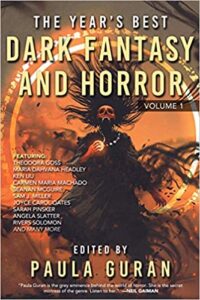A note from the editor:
We are getting near the end of November and Monster Librarian still needs to raise the funds to pay for our hosting fees and postage in 2021. If you like what we’re doing, please take a moment to click on that red “Contribute” button in the sidebar to the right, to help us keep going! Even five dollars will get us closer to the $45 we still need to keep going at the most basic level. We have never accepted paid advertising so you can be guaranteed that our reviews are objective. We’ve been reviewing and supporting the horror community for 15 years now, help us make it another year! Thank you! And now our review of The Year’s Best Dark Fantasy & Horror: Volume 1 edited by Paula Guran.
 ( Amazon.com )
( Amazon.com )
The Year’s Best Dark Fantasy & Horror: Volume 1, edited by Paula Guran, cover design by Jennifer Do
Pyr Books, 2020
ISBN: 9781645060253
Available: Trade paperback, Kindle edition
After ten volumes of the series with Prime Books, acclaimed editor Paula Guran has moved to Pyr to continue her relentless search for the best dark fiction published during the previous year (in this case 2019). The present “debut” volume with the new publisher includes 25 short stories that were previously published in various genre anthologies and magazines.
As a confirmed horror fan, it seems to me that this time the balance is a bit too much in favor of fantasy tales, although, admittedly, the boundary between the two genres is often very thin.
Commenting upon such a huge anthology, featuring such a high number of stories, is a difficult task, so I will take advantage of my privilege as a reviewer to pinpoint just my favorite stories.
“The Promise of Saints” by Angela Slatter is a little gem of religious horror featuring a naive girl and a powerful saint, while “Burrowing Machines” by Sara Saab is an intriguing tale set in the claustrophobic bowels of London, between the Tube and the elusive River Fleet.
In the short but effective “Haunt” by Carmen Maria Machado we meet a ghost who’s not a ghost, and in the disturbing “The Coven of Dead Girls” a group of murdered girls is haunting the house of their serial killer.
To me, the best story is Pat Cadigan’s “About the O’Dells”, a superbly written piece in which a murder from the past casts shadows on the neighborhood and affects the mind of a young girl.
As with any anthology, this one is a mixed bag, but well worth reading. Recommended for adult readers.
Reviewed by Mario Guslandi






Follow Us!